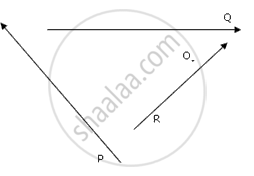Advertisements
Advertisements
प्रश्न
In each of the following a force, F is acting on an object of mass, m. The direction of displacement is from west to east, as shown by the longer arrow. Observe the diagrams carefully and state whether the work done by the force is negative, positive or zero.

उत्तर
- The work done is zero because the force acts perpendicular to the displacement.
Work done at angle θ = F × s × cosθ
W = F × s × cos90∘ - The work done is positive because the object's displacement occurs in the direction of the applied force.
- The work done is negative because the object's displacement occurs in the opposite direction of the applied force.
APPEARS IN
संबंधित प्रश्न
State two conditions when no work is done by a force.
Define 1 joule of energy.
Give reasons for the following. No work is done if a man is pushing against a wall.
Fill in the blank with suitable word :
Work is measured as a product of __________ and __________
Explain by an example that a body may possess energy even when it is not in motion.
P, Q and R are three forces which act as shown in fig.

The point O lies in the same plane. Given, P = Q = R = 10N
(i) Which force has the least moment about O? Give a reason.
(ii)Which force has the greatest moment about O? Give a reason.
State the conditions of equilibrium for a rigid body.
Is power a scalar quantity?
Distinguish between work and power.
Complete the following sentences:
1 H.P. = ........ W.
How fast should a boy weighting 30 kg run so that his kinetic energy is 375 joule?
What do you understand by 'potential energy' and 'Kinetic energy'? Give three examples of each to illustrate your answer.
State the energy changes which take place when An electric bulb glows when it is connected to a source of electric current.
Why is less effort needed to lift a load over an inclined plane as compared to lifting the load directly?
Who is the odd one out?
Work done by this force at any instant is ______.
